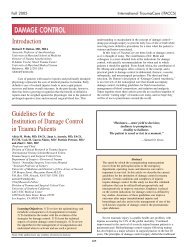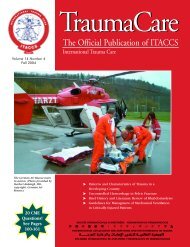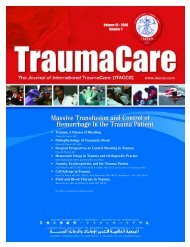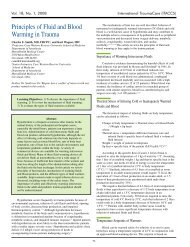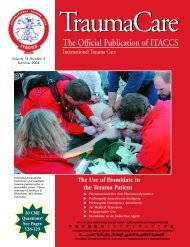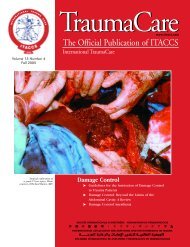The Official Publication of ITACCS - International Trauma ...
The Official Publication of ITACCS - International Trauma ...
The Official Publication of ITACCS - International Trauma ...
You also want an ePaper? Increase the reach of your titles
YUMPU automatically turns print PDFs into web optimized ePapers that Google loves.
<strong>ITACCS</strong> Spring 2003<br />
large volume proximal cuff is made <strong>of</strong> Neoprene; therefore, the device is suitable for patients<br />
allergic to latex.<br />
<strong>The</strong> EzT is available in two sizes (41 and 27 Fr), making the device applicable for<br />
patients from a height <strong>of</strong> 90 cm on.<br />
SLAM Emergency Airway Flowchart: Universal Considerations<br />
for the Emergency Airway<br />
James M. Rich, MA, CRNA<br />
Baylor University Medical Center, Dallas, TX, USA<br />
Learning Objective: To understand the need for acquisition <strong>of</strong> critical decisionmaking<br />
skills to effectively deal with a wide range <strong>of</strong> emergency airway situations.<br />
Purpose <strong>of</strong> Work. <strong>The</strong> purpose <strong>of</strong> the work was 1) to collate and organize current<br />
information on emergency airway management in a single flowchart that provides a clear<br />
strategy for effectively dealing with emergency airway situations that occur in and out <strong>of</strong> the<br />
hospital; 2) to teach rapid recognition and treatment <strong>of</strong> a “crash” or “failed” airway; 3) to<br />
assist practitioners in developing critical decision making skills for emergency airway management.<br />
Although it can be applied in the operating room, it was primarily developed for<br />
providers outside the operating room and hospital.<br />
Method Used. A literature review was used to collect current peer-reviewed information<br />
on emergency airway management.<br />
Results. Material was drawn from peer reviewed sources 1–5 to develop a single “all-inone”<br />
flowchart that provides a clear strategy for dealing with a wide array <strong>of</strong> emergency airway<br />
situations. It is similar to other flowcharts in its coverage <strong>of</strong> common airway considerations<br />
such as airway assessment; oxygenation and ventilation; aspiration prophylaxis; cervical<br />
spine protection; and confirmation <strong>of</strong> tracheal intubation. However, it differs from other algorithms<br />
in the presentation <strong>of</strong> the six limbs, i.e., 1) first responder limb for providers who generally<br />
do not possess tracheal intubation skills and may or may not have rescue ventilation<br />
skills; 2) nonintubation technique limb, which allows the provider to opt out <strong>of</strong> using tracheal<br />
intubation if the situation dictates and to either continue with a nonrebreathing mask or bagvalve<br />
mask ventilation or proceed with a minimally invasive technique such as Combitube,<br />
COPA, Easy Tube, King LT or LMA; 3) rescue ventilation limb, which provides for rapid insertion<br />
<strong>of</strong> a Combitube or LMA or LMA-Fastrach in the presence <strong>of</strong> a crash airway or failed airway<br />
situation; 4) difficult intubation limb, which provides options for facilitating a difficult<br />
intubation; 5) RSI limb, which focuses on appropriate use <strong>of</strong> rapid sequence intubation; and<br />
6) cricothyrotomy limb for application if rescue ventilation fails.<br />
<strong>The</strong> flowchart assists in improving oxygenation and ventilation regardless <strong>of</strong> the<br />
provider’s skill level. Other contributions include use <strong>of</strong> limiting intubation attempts to avoid<br />
traumatizing the airway or creating a “cannot ventilate–cannot intubate”; 6 “Mason’s PU-92<br />
Concept” for rapid recognition <strong>of</strong> the crash airway 1 ; maxims and special considerations to<br />
facilitate airway safety; technique adjustment if adequate oxygenation is not being attained or<br />
maintained; clear criteria for application <strong>of</strong> rescue ventilation to treat a failed or crash airway;<br />
criteria for application <strong>of</strong> cricothyrotomy; and near-failsafe devices in all locations to confirm<br />
tracheal intubation. Use <strong>of</strong> color to show safe blocks, danger blocks, decision blocks, consideration<br />
blocks, and action blocks aids in instruction and acquisition <strong>of</strong> information.<br />
Conclusions. A flowchart has been developed that can be used by all practitioners<br />
involved in emergency airway management. It provides a platform for teaching critical decision-making<br />
skills to diverse practitioners. It is hoped that a tool can be developed to measure<br />
its effect on providers’ ability to apply critical decision-making skills effectively in emergency<br />
airway management. <strong>The</strong> flowchart is germane to that common area <strong>of</strong> emergency airway<br />
management where the diverse fields <strong>of</strong> anesthesiology, emergency medicine, and prehospital<br />
care coincide.<br />
References<br />
1. Mason AM. <strong>The</strong> Laryngeal Mask Airway (LMA) & Intubating Laryngeal Mask Airway<br />
(ILMA) in Prehospital <strong>Trauma</strong> Care. Presentation at the Royal College <strong>of</strong><br />
Anaesthetists, London, May 13, 2002.<br />
2. ASA Task Force on Management <strong>of</strong> the Difficult Airway. Anesthesiology 1993; 78:597.<br />
3. Gabbott DA. Management <strong>of</strong> the airway and ventilation during resuscitation. Br J<br />
Anaesth 1997; 79:159–71.<br />
4. Walls RW. <strong>The</strong> emergency airway algorithms. In Walls RW, ed. Manual <strong>of</strong> Emergency<br />
Airway Management. Philadelphia: Lippincott Williams & Wilkins, 2000, pp 16–26.<br />
5. Smith CE, Grande CM, Wayne MA, et al. <strong>ITACCS</strong> Rapid Sequence Intubation (RSI)<br />
in <strong>Trauma</strong> [poster]. 10th ATACCS. Baltimore, May 1997.<br />
6. Benum<strong>of</strong> JL. <strong>The</strong> ASA Difficult Airway Algorithm: new thoughts and considerations.<br />
In Hagberg CA, ed. Handbook <strong>of</strong> Difficult Airway Management. Philadelphia:<br />
Churchill Livingstone, 2000, pp 31–48.<br />
Flexible Fiberoptic Intubation<br />
Freddy Lippert, MD<br />
<strong>Trauma</strong> Center and Major Incident Command Centre, H:S Rigshospitalet, Copenhagen<br />
University Hospital, Copenhagen, Denmark<br />
Learning Objectives. To understand 1) the need for a more prominent role <strong>of</strong><br />
fiberoptic endotracheal intubation (FOI) in difficult airway management, 2) to know the<br />
indications and limitations for the use <strong>of</strong> FOI, and 3) to realize the need for acquiring the<br />
necessary skills and experience during daily practice <strong>of</strong> non-emergency situations.<br />
Difficult Airway Management. Airway management <strong>of</strong> the severely traumatized patient<br />
is <strong>of</strong>ten a challenge. <strong>The</strong> aim is to establish a secure airway. <strong>The</strong> ASA difficult airway algorithm<br />
provides various proposals for safe and simple procedures for solving difficult airway management.<br />
However, the flexible fiberoptic facilitated endotracheal intubation is down the line<br />
in the ASA algorithm, and the surgical airway is an early consideration in the advanced trauma<br />
life support (ATLS) airway algorithm.<br />
Fiberoptic Intubation. Various techniques have being developed. For a safe, awake FOI<br />
technique, the airway must be anesthetized sufficiently to avoid coughing, gagging, and vomiting.<br />
Various techniques have been described but time consumption might be a limitation.<br />
In the conscious patient, transtracheal injection <strong>of</strong> local anesthetic is easy, simple, and effective.<br />
Subsequent topicalization <strong>of</strong> the airway provides further tolerance <strong>of</strong> the fiberoptic<br />
scope, and additional spraying <strong>of</strong> lignocaine through the suction port <strong>of</strong> an advancing<br />
fiberoptic scope is effective and efficient.<br />
Advantages. <strong>The</strong> FOI is a simple, non-traumatic technique, superb to most other technique<br />
in the hands <strong>of</strong> the experienced person. <strong>The</strong> FOI can be used for solving most <strong>of</strong> the<br />
challenges presented in difficult airway management <strong>of</strong> trauma patients. In case <strong>of</strong> a suspected<br />
difficult airway in a spontaneously breathing patient, the fiberoptic approach reveals<br />
the problem, thereby avoiding an emergency “cannot intubate situation”. <strong>The</strong> cervical spine<br />
can be protected and movements <strong>of</strong> the C-spine minimized in case <strong>of</strong> suspected C-spine<br />
injuries. Injury to the airway and penetrating neck injuries can be handled with care and<br />
diagnosed early. Hemodynamic stability is preserved during FOI with topical anesthesia. FOI<br />
provides an immediate and precise confirmation <strong>of</strong> endotracheal tube position.<br />
Disadvantages. <strong>The</strong> major disadvantage <strong>of</strong> FOI is that, like all other emergency techniques,<br />
proper use requires skills and prior experience with the equipment and the procedure.<br />
FOI is more time consuming than successful first-time conventional direct laryngoscopy.<br />
Interruption <strong>of</strong> mask ventilation might be necessary in the apneic patient. Bleeding<br />
in the upper airway is another problem making FOI more difficult or impossible. Other limitations<br />
include the relatively high costs and vulnerability <strong>of</strong> fiberoptic scopes, the immediate<br />
availability <strong>of</strong> equipment, and cleaning and maintenance <strong>of</strong> equipment.<br />
Conclusion. Direct laryngoscopy after rapid sequence induction is usually the first<br />
approach. However, the recognition <strong>of</strong> a possible difficult airway is the main issue. If possible,<br />
keep the patient awake and spontaneously breathing. FOI should be considered early if<br />
skills are available. Nasotracheal intubation is <strong>of</strong>ten easier and permitted even in trauma<br />
patients, however, with the risk <strong>of</strong> bleeding making visualization difficult. Establishing a surgical<br />
airway is not always simple and easy; the FOI is a qualified alternative. Skills end experiences<br />
should be obtained during non-emergency situations<br />
<strong>The</strong> challenge is to predict and identify the patients in whom conventional intubation<br />
is not possible or very difficult and those who will require a surgical airway as the primary<br />
choice. Prospective studies need to demonstrate the future role <strong>of</strong> FOI in emergency care.<br />
Recommended Literature<br />
Ovassapian A. Fiberoptic Endoscopy and the Difficult Airway, 2nd edition. Philadelphia,<br />
Lippincott-Raven, 1996.<br />
— Session B —<br />
Critical Care in the Age <strong>of</strong> Terrorism<br />
Chair: Maureen McCunn, MD, Baltimore, Maryland<br />
<strong>Trauma</strong> Care Around the World:<br />
How We Are Different and How We Are the Same<br />
Maureen McCunn, MD<br />
Medical Director, Neurotrauma Critical Care; Physician Director, Continuous Renal<br />
Replacement <strong>The</strong>rapies; R Adams Cowley Shock <strong>Trauma</strong> Center<br />
University <strong>of</strong> Maryland, Baltimore, Maryland, and<br />
Graduate Candidate, Johns Hopkins University, School <strong>of</strong> Advanced <strong>International</strong><br />
Studies, Washington, DC, USA<br />
<strong>Trauma</strong> . . . “the neglected disease <strong>of</strong> modern society” . . .<br />
Learning Objective: To review differences in trauma care in various countries and<br />
to highlight cultural differences.<br />
Injury is a major public health problem in the United States, developed countries, and<br />
developing nations. Blunt trauma due to vehicular craches, industrial equipment, and falls<br />
occurs across all economic strata, in addition to blast and crush injuries that may be seen in<br />
war-ravaged environments. Penetrating injuries from gunshot wounds, stabs, or landmines<br />
occur not only in combatants but more and more commonly in civilians. All populations are<br />
affected by this growing burden <strong>of</strong> injury.<br />
While published data garnered from studies <strong>of</strong> the epidemiology <strong>of</strong> injury and violence<br />
around the world are increasing, there are few to no data concerning how we can effectively<br />
intervene to implement policies or to change ineffective practices surrounding these issues.<br />
What is acceptable in any given society may not be effective in another due to social, cultural,<br />
or religious differences. <strong>Trauma</strong> care in various cultures may demand multiple paradigms<br />
as a result <strong>of</strong> these differences.<br />
Background and Significance. <strong>The</strong> World Health Organization (WHO) estimates<br />
that injury accounts for 16% <strong>of</strong> all disease worldwide. 1 <strong>The</strong> leading causes <strong>of</strong> death for both<br />
men and women between the ages <strong>of</strong> 15 and 44 years are injury related, and by 2020, injuries<br />
will be the third leading cause <strong>of</strong> death and disability in the world. 2 Interpersonal violence and<br />
war-related mortality account for approximately 5 million deaths. Based on 2000 data, 91% <strong>of</strong><br />
homicides occur in low- and middle-income countries. 3<br />
One <strong>of</strong> every ten Americans was treated for an injury in an emergency department in<br />
2000. 4 Injury is also an increasingly significant health problem in most low-income countries.<br />
However, few studies have investigated the epidemiology <strong>of</strong> injury patterns and even fewer<br />
address strategies for injury prevention. Furthermore, there are no published data that investigate<br />
the impact that social customs, religion, or cultural differences may have on trauma care.<br />
In today’s less-developed countries, infectious diseases remain the leading cause <strong>of</strong><br />
death, but this trend is decreasing and trauma is causing more and more deaths. According<br />
to the WHO report concerning the global burden <strong>of</strong> disease, road traffic craches are predicted<br />
to be the leading cause <strong>of</strong> death in the world by 2020. 5 Fifty percent <strong>of</strong> injured victims die<br />
at the scene in some countries. <strong>The</strong> preventable death rate (PDR) is about 25% in Poland,<br />
30% in Greece, 37% in Italy, and 43% to 62% in the United Kingdom. In the United States, the<br />
PDR dropped from 13% to 7% due to better and more efficient systems <strong>of</strong> trauma care. 6<br />
Unfortunately, there are very little data with regard to traumatic injury in developing nations.<br />
Recent Developments. Progress in the organization and the delivery <strong>of</strong> trauma care<br />
has resulted in decreased mortality. <strong>The</strong>se improvements include the following:<br />
• More rapid prehospital transport<br />
• Increased capabilities for prehospital care/training<br />
• Growth <strong>of</strong> emergency medicine as a specialty<br />
• Development <strong>of</strong> trauma surgery as a specialty<br />
• Advanced <strong>Trauma</strong> Life Support (ATLS) course<br />
• Development/certification <strong>of</strong> trauma centers<br />
Unfortunately, many <strong>of</strong> these changes have not reached developing nations.<br />
Differences in <strong>Trauma</strong> Care. Previous queries into trauma system effectiveness in<br />
the United States and Canada concluded that studies assessing efficacy <strong>of</strong> care rely on hospital<br />
deaths as the primary indicator <strong>of</strong> success or failure. 7 But many patients in developing<br />
nations are not even treated for their injuries ,8,9 so hospital deaths may not be an indication<br />
<strong>of</strong> true morbidity or mortality from traumatic injury. A cluster survey <strong>of</strong> household interviews<br />
has shown that many injuries and deaths in poor nations are not captured by hospital data. 10<br />
Mortality from trauma may be directly correlated with gross national product, 11 such<br />
that mortality declines with increasing economic level. Implementation <strong>of</strong> low-cost improve-<br />
49






